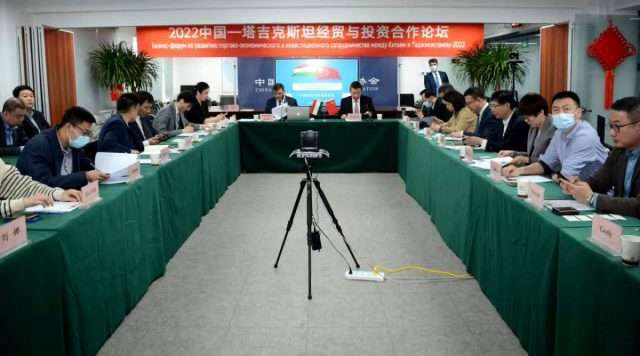
The recent Tajikistan-China business forum to develop investment cooperation highlighted Beijing’s economic strategy in the Central Asian republic and Dushanbe’s attempt to diversify its economy and attract more Chinese investors in its infrastructural projects.
On March 11th, 2022, the Embassy of the Republic of Tajikistan in the People’s Republic of China, together with the State Committee for Investment and State Property Management of the Republic of Tajikistan and in cooperation with the China Overseas Enterprise Development Association, organised a business forum to develop trade, economic and investment cooperation between Tajikistan and China.
This forum aimed to implement the agreements on expanding economic cooperation and attract Chinese companies to accelerate the country’s industrialisation reached during the meeting between the President of the Republic of Tajikistan Emomali Rahmon and the President of the People’s Republic China Xi Jinping.
During the meeting, the State Committee for Investment and State Property Management, the Ministry of Industry and New Technologies and the Tax Committee explained to Chinese companies investment opportunities, legal framework and favourable business conditions in the Republic of Tajikistan.
At the forum, the companies also presented specific projects and exchanged views. The event, which was held online and offline, was attended by a total of about 150 people, including the Ambassador of Tajikistan to China, the leadership of the State Committee for Investment and State Property Management of the Republic of Tajikistan, the State Committee for Development and Reform of China, the Secretary-General of China association for the development of enterprises abroad, representatives of ministries and departments and various companies of Tajikistan and China.
Why does it matter?
Tajikistan looks for foreign investors to boost its economic development and finance domestic infrastructural projects. Among Central Asian republics, Tajikistan financially relies more on Chinese investments allowing Beijing to exploit this economic dependence to affirm its presence and influence( Central Asian republics’ economic dependence on China). In 2011, due to Dushanbe’s incapacity of paying back loans to Beijing, Tajikistan offered 1,158 square kilometres of disputed territory in exchange for the writing off of the debt. At the beginning of 2021, China suspended debt repayments from Tajikistan since Beijing owns nearly half of Tajikistan’s 3.2 billion foreign debt pile (more than 1.2 billion dollars).
Beijing is interested in the economic and financial market and in establishing its military presence in Tajikistan. Indeed, since the U.S. troops’ withdrawal from Afghanistan, the Chinese authorities have promoted security cooperation with Dushanbe. In this framework, Tajikistan granted permission to build a military base in Gorno-Badakhshan Autonomous Region (GAUR) to support regional security and create an outpost to defend Chinese-Tajik borders (Chinese military base in Tajikistan: regional implications).
Chinese economic presence in Central Asia, especially in Tajikistan, might threaten Moscow’s Eurasian Economic Union (EAEU) and the Kremlin’s desire to remain the leading geopolitical actor in this Central Asian republic, which is part of the Russian blizhnee zarubezhe (near abroad) and where Moscow established its military presence thanks to the 201st Military Base. Although China and Russia have often promoted their good relations and partnership in different fields and against a ‘common threat’ represented by the United States, in the future, Moscow and Beijing might collide for supremacy in Central Asia and Tajikistan might become one of their ‘battle ground’.



